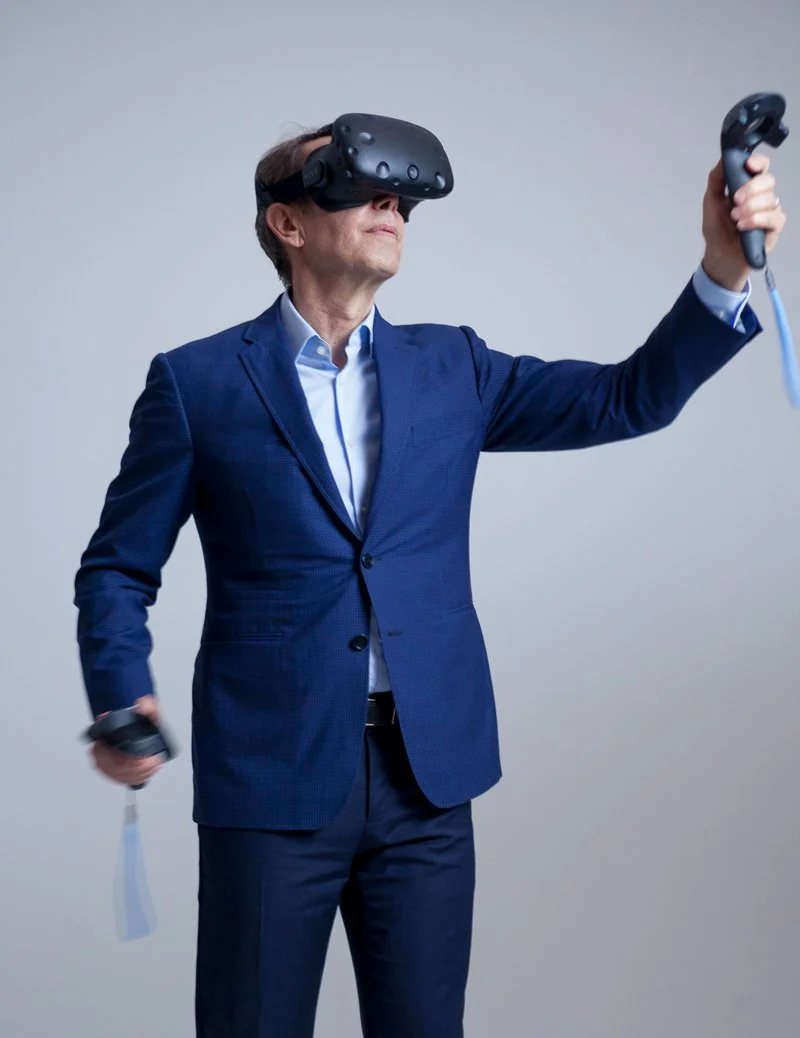Jeff Koons
Produced in collaboration with Acute Art
The name of both Koons’ work and his virtual dancer, Phryne evokes the ancient Greek courtesan, who was famed for her beauty. In Koons’ work, he explains, she greets viewers and guides them through an idealised garden: “she interacts with you; she teaches you to enjoy being human.”
“Stimulating different sense perceptions within virtual reality is new territory – and to use VR as a tool to connect to the universal is a wonderful thing”
Jeff Koons
Jeff Koons testing his VR artwork Phryne
Watch the behind the scenes
-
The artist, who is renowned world-wide for his Inflatables explains the extraordinary process of creating a virtual world populated by a glimmering dancer.
“There are many things that excite me about VR,” says Jeff Koons, discussing Phryne – a new virtual reality work produced in collaboration with Acute Art, which translates one of his iconic sculptures into a moving ballerina, set in an imagined landscape.
The name of both Koons’ work and his virtual dancer, Phryne evokes the ancient Greek courtesan, who was famed for her beauty. In Koons’ work, he explains, she greets viewers and guides them through an idealised garden: “she interacts with you; she teaches you to enjoy being human.”
This video offers an exclusive insight into the making of Phyrne – a figure based on Koons’ monumental inflatable sculpture Seated Ballerina, which was installed outside New York’s Rockefeller Center in 2017. Symbolising beauty and connectivity, the work towered at 45-feet high, with a reflective surface mirroring its surrounds.
To replicate the metallic finish of Seated Ballerina, the technicians who helped to create Phryne used specially manufactured chrome. To create movement, Koons recorded a dancer from the New York Ballet, meticulously capturing each of the sequences that appear in the finished work.
“The whole idea was to try to create something special,” Koons concludes. “Once you have your own existence affirmed, then you’re able to go on with the affirmation of other things […] I gave Phryne a metallic surface to bring in affirmation,” Viewing the work, he explains “you realise your own reflection. From that point, you can go off into abstraction.”
Behind the scenes
Motion capture
-
Jeff Koons
Phryne
Virtual Reality
Pronounced ‘Fry-nee,’ Jeff Koons’ new work is named after one of the most beautiful woman of the ancient world, and is created in the spirit of the pastoral arts. Presented as a metallic ballerina, Phryne greets viewers in an idealised garden, dancing a trail through verdant trees and hedges lined with flowers.
The metallic finish of Phryne evokes Koons’ Seated Ballerina, which was installed outside New York’s Rockefeller Center in 2017. Standing at 45-foot-high, the work was one of the largest examples of Koons’ celebrated Inflatable sculptures, and was produced in polychromed custom fabric that reflected light.
Koons explains: ‘I used Phryne’s metallic surface to bring the affirmation of self into VR. You can see your reflection within her. She affirms that your presence is real, that you exist.’ Without this, Koons adds, VR can lack a sense of center: ‘You look down at your feet and there’s nothing there – so there’s a lot to be said about defining your own presence.’
‘Stimulating different sense perceptions within virtual reality is new territory – and to use VR as a tool to connect to the universal is a wonderful thing,’ Koons adds. Conceived as a muse who informs and removes anxiety, Phyrne conveys grace and harmony – her movements based on those of a real dancer from the New York Ballet.
-
Jeff Koons was born in York, Pennsylvania in 1955. He emerged in the 1980s, becoming renowned for his bold paintings and monumental sculptures, which address subjects including popular culture and consumerist decadence. His most famous works include Rabbit (1986), a stainless-steel replica of a readymade inflatable, which stands at over a metre in height. The work is one of a series of Inflatables, which employ a monochromatic, high-gloss finish now characteristic of Koons’s output. Other iconic works include Michael Jackson and Bubbles (1988), a group of three life-size sculptures of the singer and his pet chimpanzee, finished in gold-leaf plated porcelain.
In 2014, Koons was the subject of a major retrospective at the Whitney Museum of American Art, which comprised over 100 sculptures and paintings created since 1978. The exhibition travelled to the Centre Georges Pompidou, and was presented at the Guggenheim Museum Bilbao in 2015. His first solo exhibition was held in 1980 at the New Museum in New York, eight years before his first American survey at the Museum of Contemporary Art in Chicago, in 1988. He studied at the School of the Art Institute of Chicago and the Maryland Institute College of Art, where he received a BFA in 1976. In 1980, he worked on Wall Street as a commodities broker, selecting a job that financed his first series while allowing him to remain removed from the art market. Koons lives and works in New York City.
Discover
Discover




